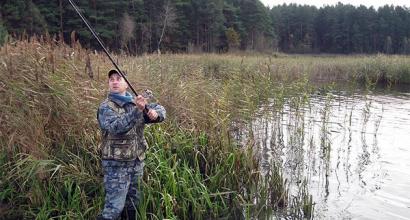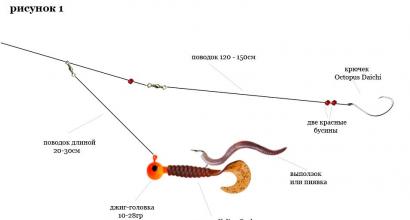We make feeder tackle - classes of feeder rods, diagrams, drawings and tips
It is used to feed fish. Casting with a feeder can be done much further than with a spinning rod and the sensitivity cannot be compared. Judging by the reviews of experienced anglers, many of them switched to feeder gear, as it is both effective and efficient.
feeder rods
In its lower part, small access rings are mounted, there are interchangeable tips, which spinning does not have, which give a bite signal. They are changed in accordance with the weight of the feeder, so the tops have variable stiffness.
Feeder rod classes
- Light (light) - bait weight up to 40g
- Medium (medium) - bait weight 40-80g
- Heavy (heavy) - the weight of the bait is more than 80g
- Ultralight (picker) - bait weight up to 40g
- Extra-heavy (extraheavy) - the weight of the lure is more than 180g
Most often, they choose the middle one, which can be used in most cases by a beginner and an experienced fisherman.
Peculiarities
Rod length
It ranges from 2 x to 4.6 m. The components of the feeders are widely available for sale and it is not difficult to buy them. At the tops they make a bright color for the purpose of greater visibility when biting.
The length is selected based on the distance of the casts. On rivers, they usually fish with shorter rods; in bays and lakes, longer rods are used.
Rod action(bend under load)
- Fast action - top third or quarter of the rod
- Medium action-upper half
- Slow Action - Three Quarter Rod
The highest demand is for rods of fast or medium action, with a harder hook.
The coil is used inertialess, it has an increased gear ratio.
Lines in the feeder
How to catch more fish?
For 13 years of active fishing, I have found many ways to improve the bite. And here are the most effective ones:- Cool activator. Attracts fish in cold and warm water with the help of pheromones included in the composition and stimulates their appetite. It's a pity that Rosprirodnadzor wants to ban its sale.
- More sensitive gear. Read the relevant manuals for the particular type of tackle on the pages of my website.
- Lures based pheromones.
When fishing with a long cast, braided line is used. The diameter of the fishing line when catching fish weighing up to 1 kg is sufficient 0.13-02mm, over 1kg 0.2-0.25mm. Braided fishing line is better to use with a diameter of 0.11-0.2 mm.
Leashes
For feeder leads, it is best to use fluorocarbon line. The length of the leash is 30-60 cm, with a weak bite, the leash is made longer, with a good bite, it is shorter.
Hooks for tackle
Hooks No. 10-No. 18 are used, occasionally other numbers.
Equipment types
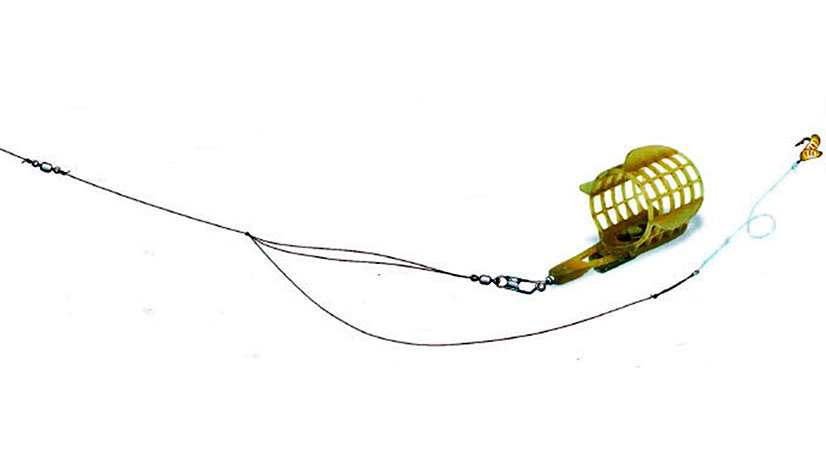
Paternoster or Gardner loop:
- Symmetric loop;
- Asymmetrical (asymmetric) loop;
- Equipment with an anti-twist (with a tube);
- With sliding feeder.
Line attachment
The fishing line is chosen the strongest, and this is braided. After each fishing, the line is unwound from the reel with the help of a special spin-doctor load. When fastening hooks, knotless fasteners must be used.
Leash
For a leash, you need to use a braided fishing line to avoid tearing off the hook. The angler needs a lot of leashes, with different hooks.
Fishing Basics
Bait with bait is cast to increase the concentration of fish in the bait zone, and in order to accurately cast it, you need to practice. With the help of a coil stopper, the casting distance is fixed.
playing
When playing fish, it should be taken into account that self-hooking occurs when fishing with heavy feeders, and using light fish you need to hook.
Catching Tactics
Casts are optimal every 10-15 minutes. It is advisable to catch with one feeder, and not use 2-3, as they interfere with each other when biting.
Starter food
Before fishing, they make a starting feed, the same components will interfere with the feeder as for the nozzle.
Feeding Requirements
Complementary foods should leave the feeder within 5 minutes.
Feeding time
Feeding times can range from a few minutes to one hour.
Advantages and disadvantages of feeder equipment

Advantages: Lack of overlaps of the leash and resistance to twisting of the fishing line. Ease of installation, ease of holding the bottom, high sensitivity, minimum hooks.
Flaws: The need for proportionality in the length of the leash and the tube, a large windage that interferes with casting, it is difficult to catch if the bottom is muddy.
How to make a feeder tackle with your own hands?
Although the gears differ from each other in the way they are attached, they have the same elements. To make tackle directly at the place of fishing, you need a knife, fishing line and your own hands.
Rig Gardner
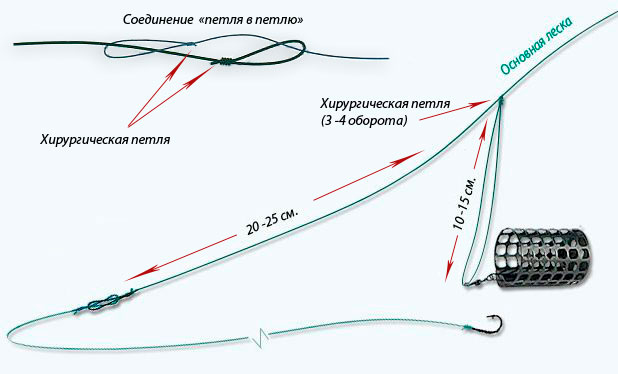
The main thing is to make a loop 15 cm long, spaced from the end of the main fishing line by about 30 cm. The loop is necessary to attach the feeder. Make a small loop at the end of the main one to attach the leash. The leash is 60 cm long.
Symmetric loop
They take a fishing line one and a half meters long and 0.25 mm thick:
- Fold the line in half.
- Make a small loop in the bend of the fishing line.
- The ends of the fishing line are tied.
- Cut off one end.
- A swivel is tied 15 cm from the knot and connected to the main fishing line.
Asymmetrical loop
Differences with a symmetrical loop in paragraph 4. Here the unequal ends are tied at 25 and 35 cm.
Tool with anti-twist
The anti-twist prevents the feeder from twisting with the help of a swivel.
Sliding feeder rig
The feeder is attached to the main line in addition to the anti-twist. The bead is used to restrict movement.
fishing technique
Rods are placed on stands.
Stages of fishing:
- Gear is being assembled.
- They plant bait.
- They take the rod in both hands and wind it over the shoulder behind the back.
- Hold the line at the reel with the index finger
- They make a throw.
- The rod is placed on a stand and the line is reeled up.
- The signaling device is attached to the end of the fishing rod.
- The bite is shown by the bend of the rod.
- Playing and hooking fish after a bite
Feeder equipment when fishing on the current
- The weight of the feeder is selected so that it easily moves along the bottom, but is not carried away by the current.
- A long flexible rod is placed steeply above the water.
- A strong, albeit heavy, reel is better than a light one.
- Braided line is preferable to mono, you can cast farther with it. Unwinding must be provided within 150 m. Since part of the fishing line or braid quickly fails, a reserve must be provided.
Feeder equipment for still water fishing
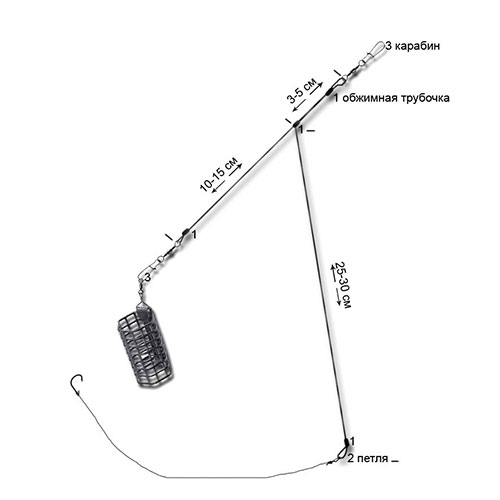
- In stagnant water, the bait remains in the feeder for a long time.
- At close casting distances, it is good to catch with a light feeder, up to 3.6 m.
- At distances of about 50 m, a medium one, 4.2 m long, is suitable.
- The super-heavy class with a length of more than 4 m is used for long-distance casts.
- For standing water, monofilament line is better, which stretches well and there are fewer descents with such line.
- Feeding troughs in stagnant water are more often used mesh open type.
Feeder equipment for bream
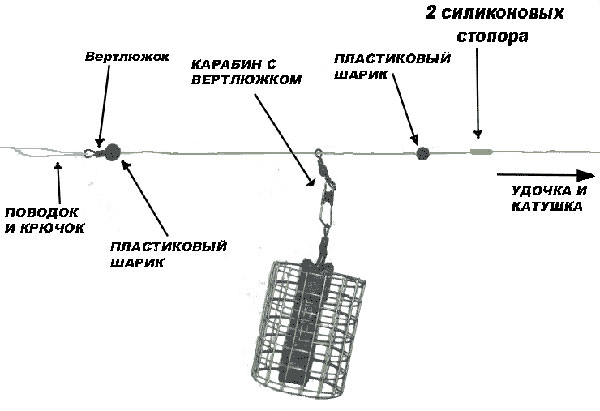
In stagnant water, feeders weighing 50 g are used; paternoster rigs or an asymmetrical loop are suitable for attaching them.
Hooks choose from 10 to 14 numbers. If the terrain is uneven, then it is better to use an oval, free-rolling basket for food.
For catching bream in backwaters, loose dressing is used with the addition of worms and maggots.
Feeder equipment for crucian carp
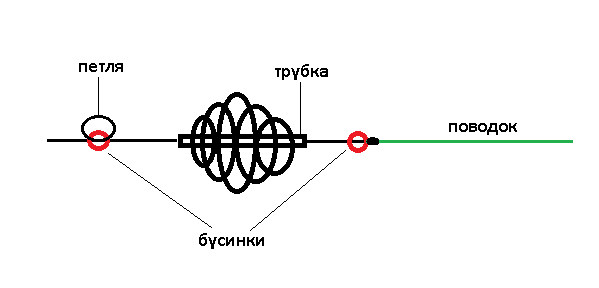
- For carp fishing, rods with a length of 2.7-4.5 m are taken, preferably strong ones made of high-modulus graphite.
- Usually, medium-fast or fast test rods are suitable for crucian carp.
- Usually, for catching crucian carp, they take a fishing line 0.2 mm thick, the leash is even thinner, 012 mm.
- For the initial bait, you can use an open feeder from a large-capacity mesh, when fishing in the middle course. The frame type is used if the bottom is muddy.
- The hook must match the color and size of the bait used, as well as the size of the fish. Usually take hooks No. 8-No. 12.
Most often they make an asymmetrical loop or Gartner's Paternoster:
- First of all, the rod is assembled. In this case, you need to make sure that the rings are located on the same line.
- Fix the coil on the holder. Pass the end of the line through the spool and slowly rotate the spool for even winding.
- With a distance of 10-12 cm, two nodal loops are made. A swivel with a carabiner is mounted, it serves to change the feeders, the leash with the feeder is placed on the end loop.
- They cast the equipment and monitor the bite.
Bite alarms for feeder
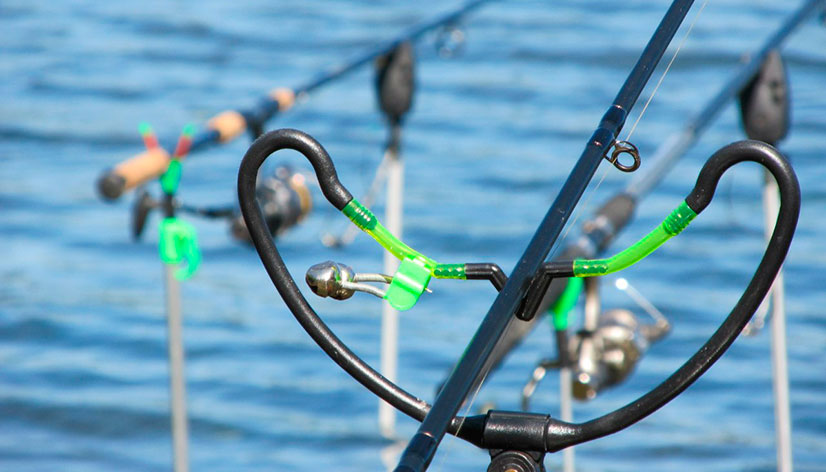
visual
Signaling devices make it easier to track bites
The following are better known:
Float
A foam float is selected, in accordance with the weight of the tackle. It is necessary that the float does not lie down and the tackle does not sink. A retaining ring is attached to the fishing line, it regulates the degree of immersion of the feeder.
Such a signaling device shows a bite, like a conventional float.
Nod
A spring or steel wire is attached to the end of the tip, a fishing line is passed through the spring, the sensitivity is adjusted.
Firefly
Take a clothespin or a clerical clip "frog". A fishing firefly is bought in the store, a chemical or LED firefly is attached to the “frog” ears, and the clip itself is attached to the tip.
foil tube
The simplest alarm. You need aluminum foil and a tube thicker than the first ring on the rod. The tube wrapped in foil is simply put on the rod.
We make feeder tackle - classes of feeder rods, diagrams, drawings and tips

